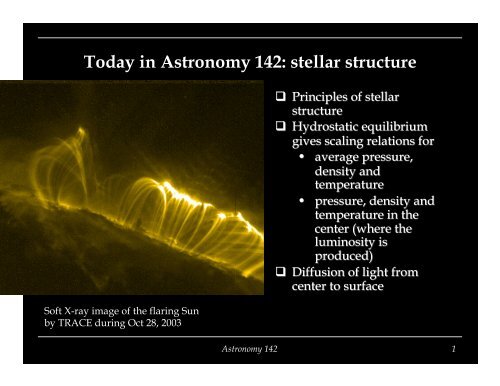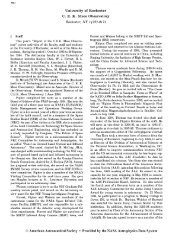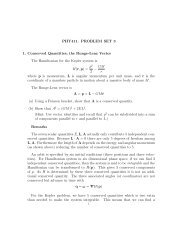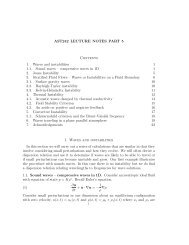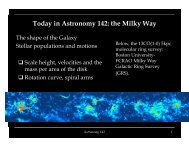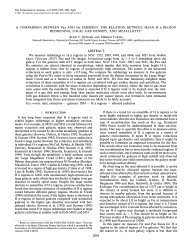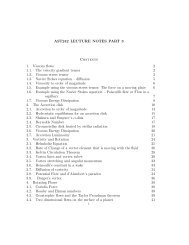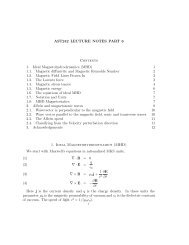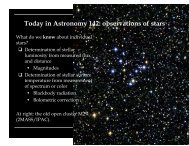Lecture 4 - Astro Pas Rochester
Lecture 4 - Astro Pas Rochester
Lecture 4 - Astro Pas Rochester
Create successful ePaper yourself
Turn your PDF publications into a flip-book with our unique Google optimized e-Paper software.
Today in <strong>Astro</strong>nomy 142: stellar structure<br />
Soft X-ray image of the flaring Sun<br />
by TRACE during Oct 28, 2003<br />
<strong>Astro</strong>nomy 142 1
Principles of stellar structure<br />
! Vogt-Russell “theorem:” the mass and composition of a<br />
star uniquely determine its radius, luminosity, internal<br />
structure, and subsequent evolution.<br />
! Stars are spherical, to good approximation.<br />
! Stable stars are in hydrostatic equilibrium: the weight of<br />
each infinitesimal piece of the star’s interior is balanced by<br />
the force from the pressure difference across the piece.<br />
• Most of the time the pressure is gas pressure, and is<br />
described well in terms of density and temperature by<br />
the ideal gas law, PV = NkT.<br />
• However, in very hot stars or giant stars, the pressure<br />
exerted by light -- radiation pressure -- can dominate.<br />
<strong>Astro</strong>nomy 142 2
Principles of stellar structure (continued)<br />
! Energy is transported from the inside to the outside, most<br />
of the time in the form of light.<br />
• The interiors of stars are opaque. Photons are absorbed<br />
and reemitted many many times on their way from the<br />
center to the surface: a random-walk process called<br />
diffusion.<br />
• The opacity depends upon the density, temperature<br />
and chemical composition.<br />
• Most stars have regions in their interiors in which the<br />
radial variations of temperature and pressure are such<br />
that hot bubbles of gas can “boil” up toward the<br />
surface. This process, called convection, is a very<br />
efficient energy-transport mechanism and can be more<br />
important than light diffusion in many cases.<br />
<strong>Astro</strong>nomy 142 3
The equations of stellar structure<br />
<strong>Astro</strong>nomy 142 4
These equations can be derived from<br />
physics conservation laws<br />
Conservation of mass<br />
Conservation of momentum →Euler’s equation<br />
→Hydrostatic equilibrium (in steady state)<br />
Conservation of energy→Energy transport equation<br />
depends on opacity and convection<br />
Equation of state relates pressure to temperature and<br />
density, derived from statistical/thermodynamics<br />
<strong>Astro</strong>nomy 142 5
The equations of stellar structure (continued)<br />
! There are no general, analytical solutions to the equations;<br />
usually stellar-interior models are generated by computer<br />
solution.<br />
! Instead of solving these equations, we shall employ some<br />
crude approximations to develop several scaling<br />
relationships that will also be crude, but will correctly<br />
illuminate the physical processes important in stars.<br />
! First we will derive the equation of hydrostatic<br />
equilibrium.<br />
<strong>Astro</strong>nomy 142 6
Hydrostatic equilibrium<br />
Consider a spherical shell of<br />
radius r and thickness Δr
Hydrostatic equilibrium (continued)<br />
If the star is in hydrostatic equilibrium the weight is balanced<br />
by the pressure difference across the shell:<br />
This differential equation, one of the equations of stellar<br />
structure, can be solved easily under certain assumptions.<br />
<strong>Astro</strong>nomy 142 8
Another way to derive this, using Euler’s equation<br />
Euler’s equation for a fluid<br />
We assume time independent so that<br />
Assume that the velocities are zero (in equilibrium)<br />
Gravitational potential<br />
Sub in and get<br />
<strong>Astro</strong>nomy 142 9
Some dimensional analysis<br />
Pressure P<br />
Force/area g cm s -2 cm -2<br />
Energy/volume g cm 2 s -2 cm -3<br />
= g s -2 cm -1<br />
Combine M G R to make a pressure unit<br />
GM/R cm 2 s -2 velocity has s -2<br />
GM 2 /R 4<br />
g cm -1 s -2 expected scaling for P<br />
<strong>Astro</strong>nomy 142 10
The Sun’s interior, on the average<br />
Since we know its distance (from radar), mass (from Earth’s<br />
orbital period) and radius (from angular size and known<br />
distance):<br />
we know the average mass density (mass per unit volume):<br />
<strong>Astro</strong>nomy 142 11
Central pressure in a star<br />
The star’s center, being its densest and hottest spot, will turn<br />
out to be the site of virtually all of the star’s energy<br />
generation, so we will make somewhat more careful<br />
estimates of the conditions there.<br />
From hydrostatic equilibrium equation again:<br />
But the pressure at the surface, P(R), better be zero because<br />
the star’s surface doesn’t move and there’s nothing outside<br />
the surface to push back, so<br />
<strong>Astro</strong>nomy 142 12
Central pressure in a star (continued)<br />
We can’t do the integral unless we know the density as a<br />
function of position, so instead we make a crude<br />
approximation:<br />
(ignoring dimensionless factors like 4π/<br />
3, because we’re just trying to get the<br />
order of magnitude right),<br />
and the integral becomes<br />
<strong>Astro</strong>nomy 142 13
Central pressure in a star (continued)<br />
Central pressure (r = 0):<br />
P C ⇡ GM 2<br />
R 6<br />
Z R<br />
0<br />
r 0 dr 0 = GM 2 R 2<br />
R 6 2<br />
P C ⇡ GM 2<br />
R 4<br />
A better calculation for stars of moderate to low mass<br />
(<strong>Astro</strong>nomy 553 style) yields<br />
so we have derived a pretty good scaling relation for P C .<br />
(Note: we previously got the scaling correct with a guess)<br />
<strong>Astro</strong>nomy 142 14
For the Sun:<br />
Central pressure in a star (continued)<br />
So, for other main sequence stars, approximately,<br />
<strong>Astro</strong>nomy 142 15
Central density and temperature of the Sun<br />
Central pressure is a little more than a factor of 100 larger<br />
than average pressure. Guess: central density 100 times<br />
higher than average? (That’s equivalent to guessing that the<br />
internal temperature does not vary much with radius.)<br />
! For the Sun, that’s not bad; the central density turns out to<br />
be 110 times the average density,<br />
Since<br />
! As we will see later, the average gas-particle mass in the<br />
center of the Sun, considering its composition and the fact<br />
that the center is completely ionized,<br />
is .<br />
<strong>Astro</strong>nomy 142 16
Central density and temperature of the Sun<br />
(continued)<br />
! But the material is still an ideal gas, so<br />
! We can make a scaling relation out of this as well, to use<br />
in extrapolating to stars similar to the Sun but having<br />
different masses, sizes and composition:<br />
<strong>Astro</strong>nomy 142 17
Opacity and luminosity in stars<br />
At the high densities and temperatures found on average in<br />
stellar interiors, matter is opaque. The mean free path, or<br />
average distance a photon can travel before being absorbed,<br />
is about l = 0.5 cm for the Sun’s average density and<br />
temperature (given above).<br />
Photons produced in the center have to random-walk their<br />
way out. How many steps, or mean free paths, does it take<br />
for a photon to random-walk from center to surface? (See<br />
IAA p.P-25 and PU problem 5.11.)<br />
! Suppose photon starts off at the center of the star, and has<br />
an equal chance to go right or left after each absorption<br />
and re-emission. Average value of position after N steps is<br />
<strong>Astro</strong>nomy 142 18
Diffusion of energy to the surface in the Sun<br />
<strong>Astro</strong>nomy 142 19
Opacity and luminosity in stars (continued)<br />
! However, the average value of the square of the position<br />
is not zero. Consider step N+1, assuming the chances of<br />
going left or right are equal:<br />
hx 2 N+1i = 1 2 h(x N<br />
l) 2 i + 1 2 h(x N + l) 2 i<br />
hx 2 N+1i = 1 2 hx2 N 2x N l + l 2 i + 1 2 hx2 N 2x N l + l 2 i<br />
hx 2 N+1i = hx 2 N i + l 2<br />
! But if this is true for all N, then we can find by<br />
starting at zero and adding , N times (i.e. using<br />
induction):<br />
<strong>Astro</strong>nomy 142 20
Opacity and luminosity in stars (continued)<br />
! Thus to random-walk a distance , the photon<br />
needs to take on the average<br />
! So far, we have discussed only one dimension of a threedimensional<br />
random walk. Three times as many steps<br />
need to be taken in this case, so to travel a distance R, the<br />
photon on the average needs to take<br />
<strong>Astro</strong>nomy 142 21
Opacity and luminosity in stars (continued)<br />
! For the Sun, and for a constant mean free path of 0.5 cm,<br />
N ⇡ 3(7 ⇥ 1010 cm) 2<br />
(0.5cm) 2<br />
⇡ 6 ⇥ 10 22 steps<br />
! Each step takes a time , so the average time it<br />
takes for a photon to diffuse from the center of the Sun to<br />
the surface is<br />
Note that the same trip only takes<br />
photon traveling in a straight line.<br />
for a<br />
<strong>Astro</strong>nomy 142 22
Diffusive approximations<br />
@f(x, t)<br />
@t<br />
= @<br />
@x<br />
apple<br />
D<br />
@f(x, t)<br />
@x<br />
f(x,t) is a quantity such as concentration or<br />
Temperature or energy density<br />
The flux depends on the gradient<br />
Units of the diffusion coefficient D (cm 2 s -1 )<br />
D is a velocity times a length scale<br />
@f(x, t)<br />
@x<br />
<strong>Astro</strong>nomy 142 23
Diffusive approximations (continued)<br />
<strong>Astro</strong>nomy 142 24
Summary<br />
! Using hydrostatic equilibrium to estimate central<br />
pressures in stars<br />
! Using the equation of state to estimate the central<br />
temperature in stars.<br />
! Using a diffusive approximation and a mean free path<br />
to estimate the time it takes for photons to diffuse to the<br />
surface from the center of the Sun.<br />
<strong>Astro</strong>nomy 142 25


